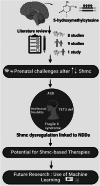Exploring the epigenetic landscape: The role of 5-hydroxymethylcytosine in neurodevelopmental disorders
- PMID: 38699519
- PMCID: PMC11062787
- DOI: 10.1017/pcm.2024.2
Exploring the epigenetic landscape: The role of 5-hydroxymethylcytosine in neurodevelopmental disorders
Abstract
Recent advances in genetic and epigenetic research have underscored the significance of 5-hydroxymethylcytosine (5hmC) in neurodevelopmental disorders (NDDs), such as autism spectrum disorder (ASD) and intellectual disability (ID), revealing its potential as both a biomarker for early detection and a target for novel therapeutic strategies. This review article provides a comprehensive analysis of the role of 5hmC in NDDs by examining both animal models and human studies. By examining mouse models, studies have demonstrated that prenatal environmental challenges, such as maternal infection and food allergies, lead to significant epigenetic alterations in 5hmC levels, which were associated with NDDs in offspring, impacting social behavior, cognitive abilities and increasing ASD-like symptoms. In human studies, researchers have linked alterations in 5hmC levels NDDs through studies in individuals with ASD, fragile X syndrome, TET3 deficiency and ID, specifically identifying significant epigenetic modifications in genes such as GAD1, RELN, FMR1 and EN-2, suggesting that dysregulation of 5hmC played a critical role in the pathogenesis of these disorders and highlighted the potential for targeted therapeutic interventions. Moreover, we explore the implications of these findings for the development of epigenetic therapies aimed at modulating 5hmC levels. The review concludes with a discussion on future directions for research in this field, such as machine learning, emphasizing the need for further studies to elucidate the complex mechanisms underlying NDDs and to translate these findings into clinical practice. This paper not only advances our understanding of the epigenetic landscape of NDDs but also opens up new avenues for diagnosis and treatment, offering hope for individuals affected by these conditions.
Keywords: 5-hydroxymethylcytosine; DNA methylation; autism; epigenetics; neurodevelopment; precision psychiatry.
© The Author(s) 2024.
Conflict of interest statement
The authors declare that the research was conducted in the absence of any commercial or financial relationships that could be construed as a potential conflict of interest.
Figures



References
-
- American Psychiatric Association (1994) Diagnostic and Statistical Manual of Mental Disorders, DSM-IV.
-
- American Psychiatric Association (2022) Neurodevelopmental Disorders. Diagnostic and Statistical Manual of Mental Disorders. 10.1176/appi.books.9780890425787.x01_neurodevelopmental_disorders. - DOI
Publication types
LinkOut - more resources
Full Text Sources
Research Materials
